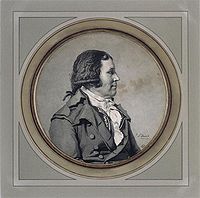- Edmond Louis Alexis Dubois-Crancé
-
Edmond Louis Alexis Dubois-Crancé (14 October 1747 – 28 June 1814) was a French soldier and politician.
Contents
National and Constituent Assemblies
Born in Charleville, Ardennes, he was at first a musketeer, then a lieutenant of the Marchaux (guardsmen of the Ancien Régime), and embraced Liberalism. At the start of the French Revolution in 1789, he was elected deputy to the States-General by the Third Estate of Vitry-le-François, and joined the National Assembly (his portrait stands in the foreground in Jacques-Louis David's celebrated sketch of the Oath of the Tennis Court).
In the Constituent Assembly, of which he was named secretary in November, Dubois-Crancé carried out activities in support of military reforms. He aimed for the replacement of the old military system, one of promotions on the basis of aristocratic origin and reliance on mercenaries, replaced by an organization of National Guards in which all citizens should be admitted. In his report, submitted on 12 December 1789, he was the first one to promote the idea of conscription, which he opposed to the recruiting system practiced; however, the document was not adopted. He succeeded in securing the Assembly's vote that any African slave who touched French soil should become free.
National Convention
After the Constituent, Dubois-Crancé was named maréchal-de-camp, but he refused to be placed under the orders of the Marquis de La Fayette and preferred to serve as a simple grenadier.
Elected to the French Republic's National Convention by the Ardennes département, he sided with the The Mountain, but without following any one leader - either George Danton or Maximilien Robespierre. During the trial of King Louis XVI, Dubois-Crancé voted for death penalty without delay or appeal. On the 21 February 1793, he was named president of the Convention.
Although he was a member of the two committees of general defence which preceded the Reign of Terror's Committee of Public Safety, he did not belong to the latter at its creation. Instead, he composed an important report on the state of the French Revolutionary Army, recommending two measures which contributed largely to its success - the rapid advancement of the lower officers, which opened the way for the most successful generals of the Revolution, and the fusion of the volunteers with the veteran troops.
Clash with Robespierre, the Directory, and 18 Brumaire
In August 1793, Dubois-Crancé was designated representative on mission to the army of the Alps, to direct the siege of Lyon, which had revolted against France's government. Accused of "lack of zeal", he was replaced by Georges Couthon. On his return he defended himself, but was excluded from the Jacobin Club at the instance of his rival Robespierre. Consequently, he was approached to take part in the Thermidor Coup that toppled Robespierre in July 1794. However, he would not join the Royalist reaction which followed, and was one of the Committee of Five which had to oppose the Royalist insurrection known as 13 Vendémiaire (in October 1795).
It was also during this period that Dubois-Crancé was named a member of the Committee of Public Safety, already much reduced in importance. After the Convention, under the Directory, Dubois-Crancé was a member of the Council of Five Hundred, and was appointed Inspector General of infantry, then, in 1799, minister of war. In November, he also opposed Napoleon Bonaparte's coup d'état (the 18 Brumaire), and lived in retirement during Consulate and the Empire, dying in Rethel.
References
 This article incorporates text from a publication now in the public domain: Chisholm, Hugh, ed (1911). Encyclopædia Britannica (11th ed.). Cambridge University Press. It cites as a reference:
This article incorporates text from a publication now in the public domain: Chisholm, Hugh, ed (1911). Encyclopædia Britannica (11th ed.). Cambridge University Press. It cites as a reference:
- Thomas Jung, Dubois de Crancé. L'armée el la Revolution, 1789-1794 (2 vols., Paris, 1884).
Political offices Preceded by
Jean-Baptiste BernadotteMinister of War
14 September 1799 - 10 November 1799Succeeded by
Louis Alexandre BerthierCategories:- 1747 births
- 1814 deaths
- People from Charleville-Mézières
- Deputies to the French National Convention
- French abolitionists
- Military leaders of the French Revolutionary Wars
Wikimedia Foundation. 2010.

